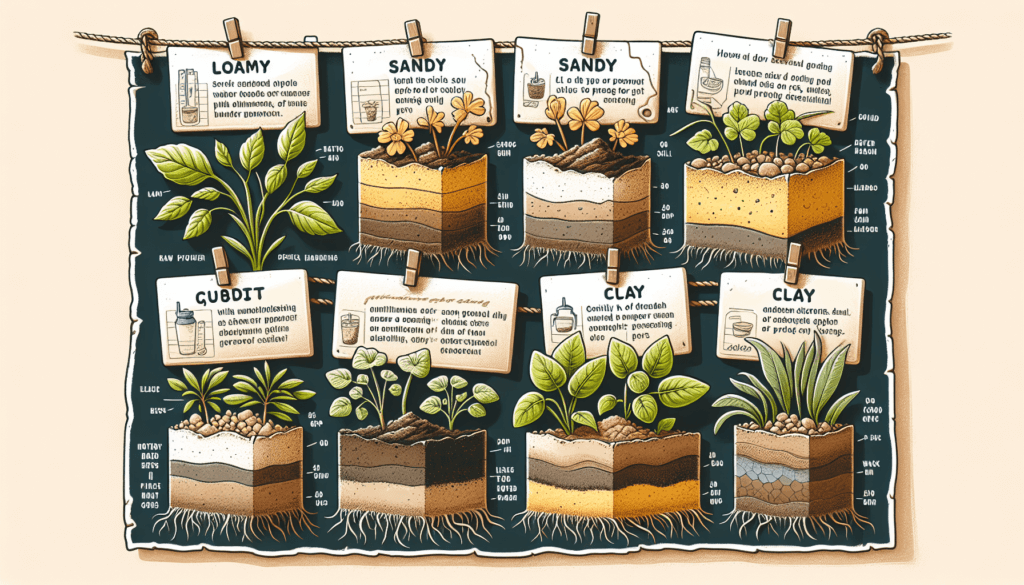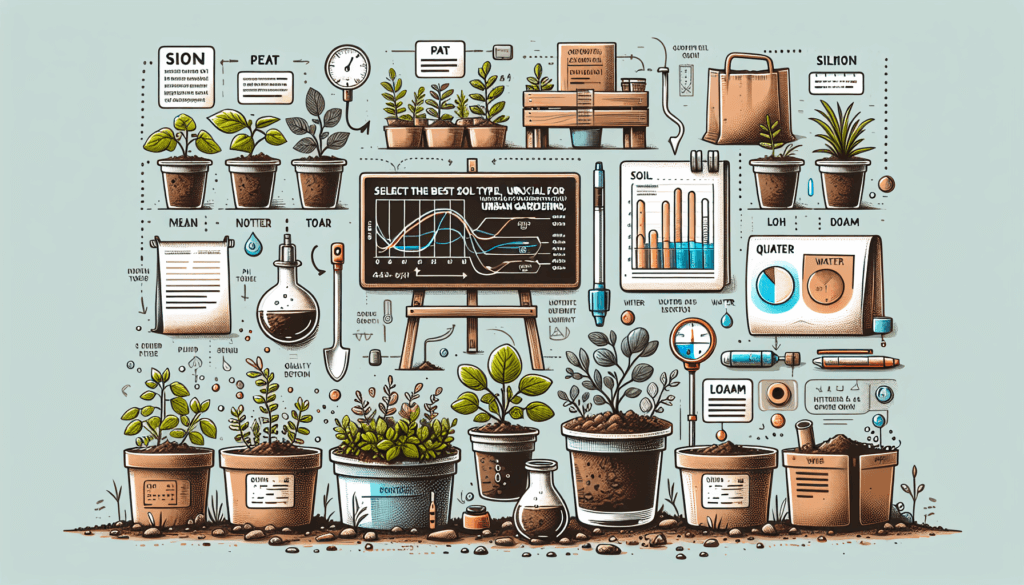Are you ready to transform your urban space into a flourishing garden oasis? In order to do so, you’ll need to start with the right soil. Whether you have a tiny balcony or a small backyard, selecting the appropriate soil is crucial for the success of your urban garden. By understanding the specific needs of your plants and considering factors such as water retention and nutrient content, you can ensure that your green thumb thrives in the city. Discover the secrets of selecting the perfect soil for your urban gardening endeavor in this article.

Factors to Consider When Choosing Soil
When it comes to urban gardening, choosing the right soil is crucial for the success of your plants. There are several factors you should consider before deciding on the type of soil to use.
Climate Conditions
One of the first factors to consider when choosing soil for your urban garden is the climate conditions in your area. Different plants thrive in different climates, so it’s important to select soil that is suitable for the specific climate in which you will be gardening. For example, if you live in a hot and dry climate, you may want to choose soil that has good water-retaining properties to help your plants stay hydrated. On the other hand, if you live in a rainy climate, you may want to choose soil that has good drainage to prevent waterlogging.
Type of Plants
The type of plants you plan to grow in your urban garden is another important factor to consider when choosing soil. Different plants have different nutrient requirements and prefer different soil types. For example, some plants thrive in acidic soil, while others prefer alkaline soil. Understanding the specific needs of your plants will help you choose soil that provides the necessary nutrients and pH balance for optimal growth.
Drainage
Proper drainage is essential for the health of your plants. Soil that retains too much water can lead to root rot and other issues, while soil that drains too quickly can cause your plants to become dehydrated. When choosing soil for your urban garden, consider the drainage characteristics of the soil. Look for soil that is well-draining but also retains enough moisture to keep your plants hydrated.
Soil pH
The pH level of soil refers to its acidity or alkalinity. Different plants have different pH requirements, so it’s important to choose soil that matches the pH preferences of your plants. Most plants prefer a slightly acidic to neutral soil pH, ranging from 6.0 to 7.0. However, there are some plants that require more acidic or alkaline soil. Testing the pH of your soil and understanding the pH requirements of your plants will help you select the right soil for your urban garden.
Nutrient Content
Plants require certain nutrients to grow and thrive. When choosing soil for your urban garden, consider the nutrient content of the soil. Look for soil that is rich in organic matter, as this provides essential nutrients to plants. Additionally, consider adding fertilizers or organic amendments to the soil to supplement the nutrient content and ensure your plants have everything they need for healthy growth.
Types of Soil for Urban Gardening
Now that you understand the factors to consider when choosing soil, let’s explore the different types of soil that are commonly used in urban gardening.
Topsoil
Topsoil is the uppermost layer of soil and is often used as a base for planting in urban gardens. It contains a mixture of organic matter, minerals, and microorganisms, making it a nutrient-rich option for your plants. Topsoil is ideal for creating new garden beds or filling raised beds.
Compost
Compost is a type of soil amendment that is created through the decomposition of organic materials such as leaves, grass clippings, and kitchen scraps. It is rich in nutrients and helps improve soil structure and fertility. Adding compost to your urban garden soil can provide a steady supply of nutrients while also enhancing water retention and drainage.
Garden Soil Mix
A garden soil mix is a pre-packaged blend of different types of soil, such as topsoil, compost, and sand. This type of soil mix is specifically formulated to provide a balanced and nutrient-rich growing medium for a wide variety of plants. Garden soil mixes are convenient options for urban gardeners who want a ready-to-use soil solution.
Potting Mix
Potting mix is a lightweight and well-aerated soil blend that is specifically designed for container gardening. It typically contains a mixture of peat moss, perlite, vermiculite, and other organic materials. Potting mix provides excellent drainage and root aeration, making it ideal for potted plants in urban gardens.
Raised Bed Mix
Raised bed mix is a specialized soil blend that is designed specifically for raised bed gardening. It is typically a mixture of topsoil, compost, and other organic materials. Raised bed mix provides optimal drainage and nutrient retention, making it a suitable choice for growing vegetables, herbs, and flowers in urban gardens.

Testing Soil Quality
Before you start planting in your urban garden, it’s important to test the quality of your soil. Testing allows you to assess the texture, nutrient content, and pH level of the soil, which will help you make informed decisions about soil amendments and plant selection.
Soil Texture Test
The soil texture test helps determine the composition of your soil. Sandy soil feels gritty and does not retain moisture well, while clay soil feels sticky and holds water for an extended period. Loamy soil, which is a mixture of sand, silt, and clay, is considered the ideal texture for most plants. To perform a soil texture test, take a small amount of soil and squeeze it in your hand. If it crumbles easily, you have sandy soil. If it forms a ball that holds its shape, you have clay soil. If it forms a ball that breaks apart when lightly pressed, you have loamy soil.
Soil Nutrient Test
A soil nutrient test helps determine the nutrient content of your soil. This test measures the levels of essential nutrients such as nitrogen, phosphorus, and potassium, as well as secondary and micronutrients. By understanding the nutrient levels in your soil, you can determine if any amendments or fertilizers are needed to optimize plant growth. Soil nutrient tests can be done using at-home testing kits or by sending a sample to a professional laboratory for analysis.
Soil pH Test
The soil pH test measures the acidity or alkalinity of soil. A pH value below 7 indicates acidic soil, while a pH value above 7 indicates alkaline soil. Most plants prefer slightly acidic to neutral soil, with a pH range of 6.0 to 7.0. Testing the pH of your soil is important because pH levels can affect nutrient availability to plants. You can test your soil pH using a simple at-home testing kit or by sending a sample to a laboratory for analysis.
Improving Soil Quality for Urban Gardening
Once you have tested your soil and identified any deficiencies or imbalances, it’s time to improve its quality. Here are some strategies for enhancing soil health in your urban garden.
Amending Soil with Organic Matter
Adding organic matter to your soil is one of the most effective ways to improve its quality. Organic matter, such as compost, manure, and leaf litter, enhances soil structure, increases nutrient content, and improves water retention. Incorporating organic matter into your soil helps create a healthy environment for plants to thrive.
Adding Compost
Compost is a valuable soil amendment that provides essential nutrients, improves soil structure, and enhances microbial activity. It enriches the soil with organic matter and beneficial microorganisms, promoting healthy plant growth. Spread a layer of compost over your garden soil or mix it into the top few inches of soil before planting. Regularly adding compost to your urban garden will contribute to long-term soil health.
Mulching
Mulching is another effective technique for improving soil quality in urban gardens. Applying a layer of mulch, such as wood chips, straw, or shredded leaves, to the soil surface helps suppress weed growth, conserve moisture, and regulate soil temperature. As the mulch decomposes, it contributes organic matter to the soil, enriching it with nutrients over time.
Soil Aeration
Soil compaction can negatively impact plant growth by impeding root development and reducing nutrient and water uptake. Soil aeration involves loosening compacted soil to enhance its structure and improve root penetration. You can aerate the soil in your urban garden by using a garden fork or a mechanical aerator. This process increases oxygen availability to plant roots and promotes healthy soil microbial activity.

Considerations for Container Gardening
Container gardening is a popular choice for urban gardeners who have limited space. When it comes to choosing soil for container gardening, there are a few considerations to keep in mind.
Choosing the Right Containers
When selecting containers for your urban garden, choose ones that have good drainage holes and are the appropriate size for your plants. Ensure that the containers are made of a durable material that can withstand outdoor conditions. Consider the material, size, and shape of the containers to accommodate the specific needs of your plants and optimize their growth.
Finding the Right Potting Mix
Potting mix is crucial for container gardening, as it provides the necessary nutrients, drainage, and aeration for your plants. Avoid using regular garden soil in containers, as it can become compacted and hinder root growth. Look for a high-quality potting mix that is lightweight, well-draining, and specifically formulated for containers. The mix should have a good balance of organic matter, like peat moss or coconut coir, and other additives such as perlite or vermiculite for optimal plant growth.
Container Drainage
Proper drainage is essential for container gardening. Improper drainage can lead to waterlogged soil, root rot, and poor plant growth. Ensure that your containers have drainage holes at the bottom to allow excess water to escape. You can also add a layer of rocks or pebbles at the bottom of the container before adding soil to further enhance drainage. Regularly monitor the moisture levels of the soil and avoid overwatering to maintain healthy plants.
Understanding Soil Amendments
Soil amendments are materials that are added to the soil to improve its physical structure, fertility, and nutrient content. Understanding different types of soil amendments can help you enhance soil quality in your urban garden.
Organic Amendments
Organic amendments, such as compost, manure, and leaf mold, provide a rich source of organic matter to the soil. They improve soil structure, increase moisture retention, and enhance nutrient availability. Organic amendments also promote beneficial microbial activity and improve soil drainage. Additionally, they contribute to long-term soil health and sustainability.
Inorganic Amendments
Inorganic amendments, such as perlite, vermiculite, and sand, are used to modify soil properties. These amendments improve soil aeration, water drainage, and nutrient availability. They can also help loosen compacted soil and improve its overall texture. Inorganic amendments are often used in potting mixes and raised bed soils to create an optimal growing environment for plants.
Adding Fertilizers
Fertilizers are often used in conjunction with soil amendments to provide additional nutrients to plants. They can be either organic or synthetic and come in various forms, such as granules, liquids, or slow-release pellets. Fertilizers supplement the nutrient content of the soil, promoting healthy plant growth and productivity. It’s important to follow the manufacturer’s instructions and apply fertilizers in the correct quantities to avoid nutrient imbalances or plant damage.

Dealing with Soil Contaminants
In urban gardening, it’s important to be aware of potential soil contaminants and take appropriate measures to mitigate their impact on plant health.
Identifying Contaminants
Soil contamination can occur due to various factors, including heavy metals, pesticides, herbicides, and industrial pollutants. Identifying potential contaminants is crucial to understanding the risks they may pose to your plants and the surrounding environment. Conducting soil tests or consulting with local agricultural extension offices can help determine if your soil is contaminated and to what extent.
Remediating Contaminated Soil
If you discover that your soil is contaminated, there are several methods for remediation. One approach is to remove the contaminated soil and replace it with clean, uncontaminated soil. Another method is phytoremediation, which involves planting specific plants that can absorb and detoxify contaminants from the soil. Utilizing raised beds or container gardening can also help minimize exposure to contaminated soil.
Importance of Watering and Drainage
Proper watering and drainage are essential for maintaining healthy soil and promoting optimal plant growth in urban gardens.
Watering Techniques for Urban Gardens
When watering your urban garden, it’s important to use the right techniques to ensure that your plants receive adequate moisture without overwatering. Water deeply and infrequently, allowing the soil to dry out slightly between watering sessions. Use a watering can or a drip irrigation system to deliver water directly to the root zone, minimizing water runoff and evaporation. Avoid watering during the hottest part of the day to prevent water loss due to evaporation.
Importance of Proper Drainage
Proper drainage is crucial for preventing waterlogging and root rot. Good drainage allows excess water to drain away from the root zone, ensuring that the soil remains well-aerated. To improve drainage in your urban garden, consider adding amendments such as coarse sand or perlite to the soil mix. Additionally, avoid planting in low-lying areas or compacted soil that can hinder drainage.

Maintaining Soil Health
To ensure long-term success in your urban garden, it’s important to prioritize soil health and implement practices that support soil vitality.
Regular Soil Testing
Regular soil testing is crucial for monitoring the nutrient levels, pH balance, and overall health of your soil. By conducting periodic soil tests, you can identify any deficiencies or imbalances and make necessary adjustments with soil amendments or fertilizers. Soil testing also allows you to track the progress of your urban garden and ensure that your plants have the optimum growing conditions.
Crop Rotation
Crop rotation is a valuable technique for maintaining soil health and preventing the buildup of pests and diseases in your urban garden. By rotating the types of plants you grow in different areas of your garden each season, you can help prevent nutrient depletion, control pests naturally, and reduce the risk of disease outbreaks. Crop rotation also promotes healthy microbial activity in the soil and improves overall soil fertility.
Cover Crops
Cover crops are an effective tool for improving soil health and fertility in urban gardens. Planting cover crops such as clover, rye, or buckwheat during fallow periods helps prevent soil erosion, suppresses weed growth, and adds organic matter to the soil when they are eventually turned under. Cover crops also enhance soil structure, increase nutrient content, and promote beneficial soil organisms.
Avoiding Overwatering
Overwatering is a common mistake in urban gardening that can lead to waterlogged soil, root rot, and nutrient leaching. To maintain soil health, it’s important to avoid overwatering your plants. Monitor the moisture levels of the soil by sticking your finger into the soil to a depth of one inch. If it feels moist, there’s no need to water. Only water when the soil feels dry to the touch. Adjust your watering schedule based on weather conditions and the specific needs of your plants.
Tips for Purchasing Soil
When it comes to purchasing soil for your urban garden, there are a few tips to keep in mind to ensure that you get the best quality product.
Research Local Suppliers
Before purchasing soil, research local suppliers in your area. Look for suppliers who specialize in gardening or landscaping materials and have a good reputation. Read online reviews or ask for recommendations from other local gardeners to find reputable suppliers who offer high-quality soil products.
Read Product Labels
When selecting soil products, read the labels carefully to understand the composition and nutrient content of the soil. Look for organic options that are free from synthetic additives and chemical fertilizers. Ensure that the soil meets your specific requirements in terms of pH balance, nutrient content, and drainage characteristics. Reading product labels will help you make an informed decision about which soil products are best suited for your urban garden.
Consider Organic Options
In urban gardening, prioritizing organic practices is important for maintaining soil health and minimizing environmental impact. Consider opting for organic soil products that are sourced from sustainable and environmentally friendly practices. Organic soil products are typically free from synthetic pesticides and herbicides, promoting a healthy and natural growing environment for your plants.
Choosing the right soil for your urban garden is essential for the success of your plants. By considering factors such as climate conditions, plant types, drainage, soil pH, and nutrient content, you can make an informed choice about the type of soil that best suits your needs. Whether you opt for topsoil, compost, garden soil mix, potting mix, or raised bed mix, remember to regularly test and improve the quality of your soil using organic amendments, proper watering and drainage techniques, and proactive soil health maintenance. With the right soil and care, your urban garden will thrive and provide you with a bountiful harvest.


